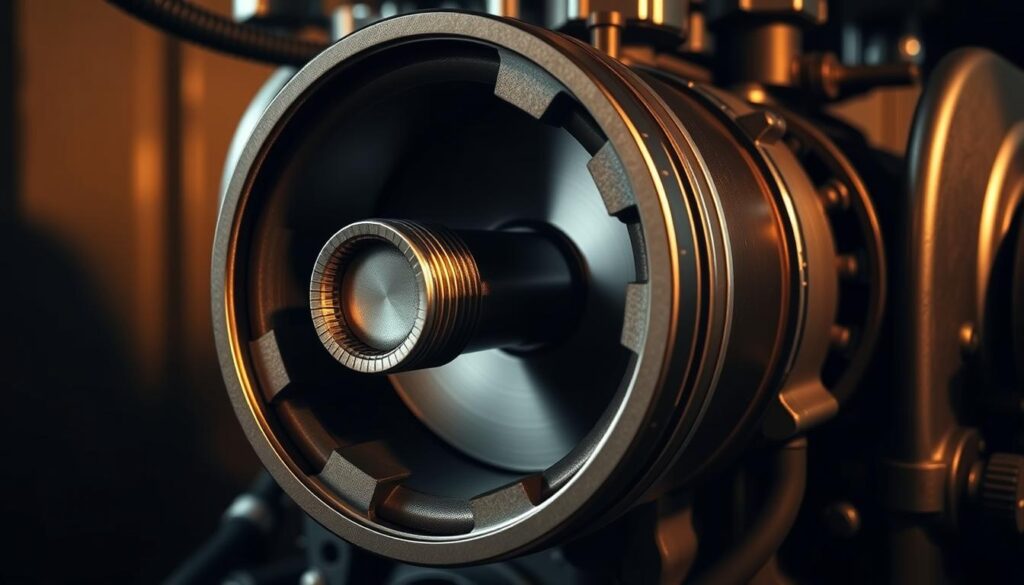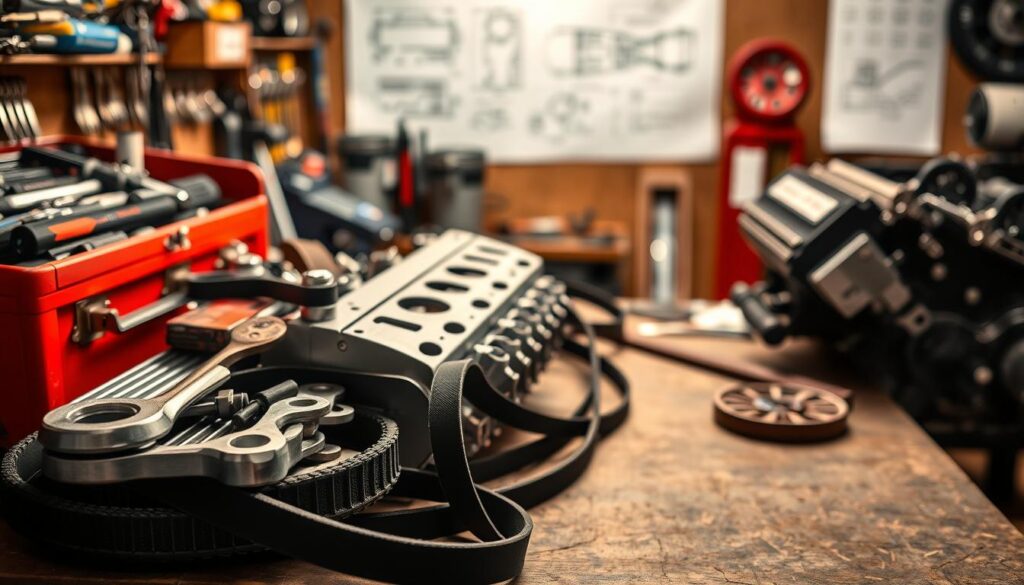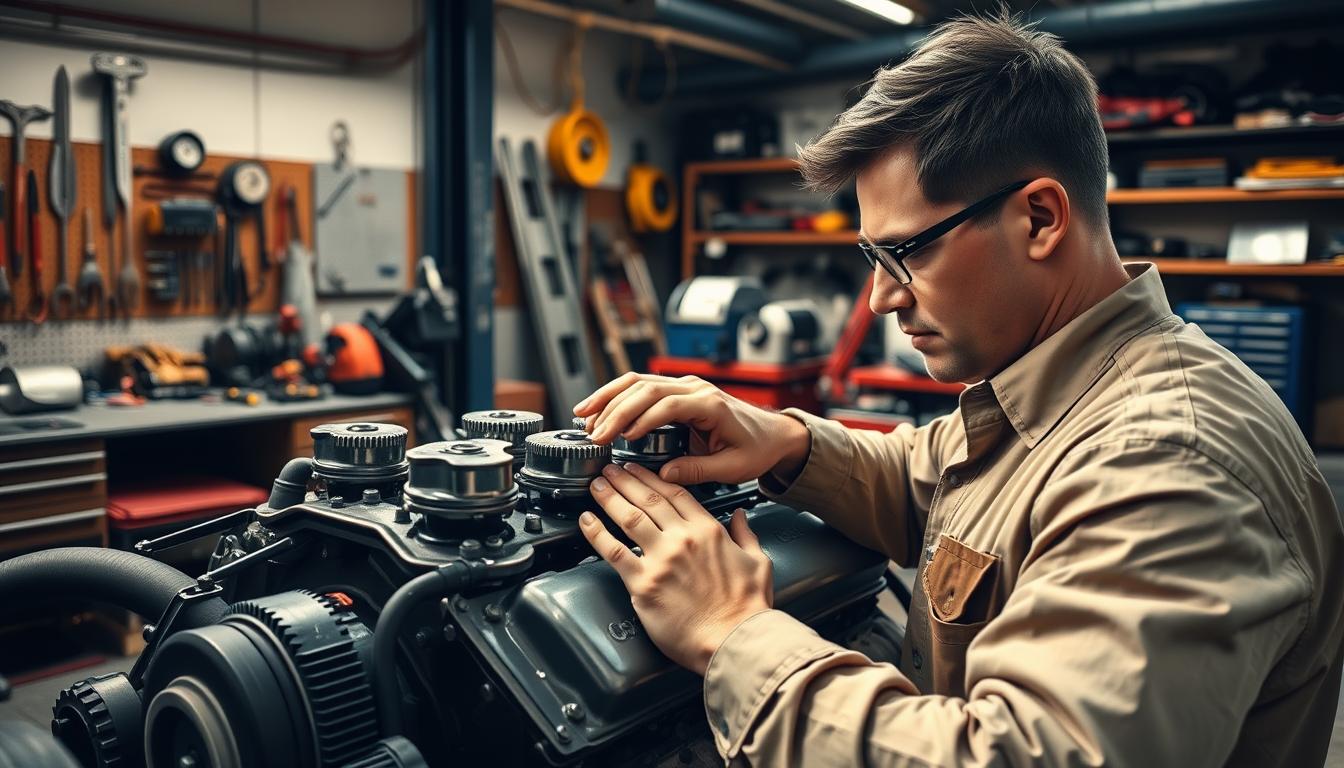Did you know that many LS1 engines make a loud, deep slap at sub-zero starts that fades after warm-up?
That simple fact can scare any owner. But the sound often points to piston slap or low oil flow, not always fatal bottom-end wear.
We set the stage by defining the challenge. Rod knock feels like a heavy tap from the oil pan. It demands attention—but not panic.
We explain how to tell this from top-end valve tap. Then we outline a clear way to listen, check oil pressure, and decide whether to shut the engine down.
Next, we preview repair paths and simple steps to quiet cold-start piston slap—safe solvents, decarbon tips, and fresh oil routines. We also note realistic costs and when machine work is needed.
Our goal is to give you the confidence to protect the engine and pick the right fix the first time.
Key Takeaways
- Cold, deep knocks can be piston slap and may fade as the engine warms.
- Listen at the pan, check oil pressure, and act fast if the sound is severe.
- Simple decarbon and fresh oil often quiet cold-start noise temporarily.
- Full repairs may require dropping the pan and inspecting bearings.
- We’ll guide you on tools, costs, and prevention steps to save the car.
Understanding Camaro engine knock today: symptoms, sounds, and what’s really happening
Hearing a deep thump from the oil pan on a cold morning raises immediate questions about engine health. We want to help you sort the sound fast, so you can choose the right next step.
Rod vs. piston sounds: bottom-end deep tap versus cold “slap”
Deep, rhythmic knocks that follow engine speed usually point to bottom-end bearing wear. A hollow, slappy noise right after a cold start most often means piston slap. Use a mechanic’s stethoscope at the oil pan for bottom tests and at valve covers for top-end checks.
Hot vs. cold behavior: why LS-based engines quiet down
Many LS designs run quiet after five minutes of gentle warm-up. Pistons expand and clearances shrink as the engine warms, so the slappy sound fades. Low-tension rings, short-skirt pistons, and longer rods all make slap more likely on freezing mornings.
Oil pressure clues at idle and cruise
Pressure readings add context. Expect roughly 50–60 psi under light throttle when cold, about 50 psi at a cold idle, and near 40 psi at warm idle on many LS1s. If pressure is in range and the noise fades, slap is likely. If noise worsens under load or stays with good pressure, suspect bearing wear at the bottom end.
- Rev the engine gently: disappearance often means slap; louder under load points to bearing issues.
- Pull the serpentine briefly to rule out accessory noise.
- Remember: spark detonation sounds sharp and pinging—different from the mechanical noises we describe.
Immediate steps to protect your engine when you hear a knock
When a loud mechanical thud comes from below, our first goal is to protect the engine fast. Stop driving if the sound is loud, constant, or worse with any throttle. That simple action prevents rapid bearing damage and expensive repairs.
How to confirm the source at the oil pan
Use a mechanic’s stethoscope or a long screwdriver. Press the tip to the oil pan rail and listen. A pronounced hit at the pan usually points to a bottom-end problem rather than a valve or accessory noise.
Quick checks to do now
Change oil and filter if you can—verify the viscosity and brand matches the climate. Many owners run Mobil 1 and report healthy cold pressure figures.
- Inspect the drained oil and filter media for shiny metal. Fine glitter may be bearing material; flakes mean more severe wear—either way, stop driving.
- Verify oil pressure with a scan tool or mechanical gauge. Compare readings to roughly 50–60 psi cold and about 40 psi at warm idle.
- Briefly remove the serpentine belt to rule out alternator or idler noise—but don’t run the engine long without the water pump.
Try a gentle warm-up test. If the noise fades and won’t get louder under load, you’re likely hearing piston slap rather than imminent rod knock. Record a short video and log pressure numbers—this helps the shop diagnose and can save an engine from serious damage.
Overcoming Rod Knock in Your Camaro Project
Dropping the oil pan is the turning point: it lets us see bearings, rod caps, and journals up close.
Drop the pan and inspect
Support the engine and clear the bay. Remove crossmembers and collect fasteners and baffles in tagged bags.
Take photos as you remove each rod cap. Mark orientation and note any copper showing, scoring, or flaking on the bearing shells.
Measure clearances and decide
Use Plastigage to verify oil clearance against spec. Excessive clearance confirms bearing wear and usually the source of the noise.
Mic the journals for taper and out-of-round. Smooth, shallow wear can often be polished. Ridges, blue discoloration, or deep scores mean shop work.
| Condition | Recommended Action | Approx. Cost |
|---|---|---|
| Light wear, within spec | Polish crankshaft journals; install new rod bearings | $200–$400 |
| Taper or minor scoring | Grind crank to undersize; fit matched bearings | $400–$800 |
| Severe damage, multiple rods | Full crankshaft machine work or replacement; rebuild engine if debris spread | $1,000–$3,000+ |
| Unknown contamination | Flush oil galleys and pickup; clean pan and filter thoroughly | $50–$200 |
Replace bearings and reassemble
Install new rod bearings with clean, oiled surfaces. Match tangs and preserve rod cap orientation.
Torque connecting rod bolts to spec and follow angle if required. Flush the pickup and pan to remove any grit.
First start and final check
Prime the oiling system, verify pressure, and run short warm cycles while listening for bottom-end noise. If multiple journals show wear, plan a full teardown and thorough cleaning.
We can get this fixed by following specs, measuring carefully, and keeping everything spotless before first start.
How to stop piston knocking that’s loud cold but fades warm

Cold-start piston slap can sound dramatic, but there are practical steps that often quiet it fast. We favor a safe decarbon routine before assuming major bottom-end work.
Decarbon strategy that works
Step one: remove the spark plugs and disable fuel and ignition. Add a measured amount of carb cleaner to each cylinder and let it soak about an hour. The GMC shop foreman’s method uses undiluted carb cleaner, then cranks the engine to blow out loosened carbon. Expect a mess and some oily smog.
Solvents: Sea Foam vs. carb cleaner
Sea Foam and similar solvents can help, but the foreman prefers undiluted carb cleaner for stubborn deposits. Avoid any product that requires rinsing with water inside a cylinder — that invites rust and more trouble.
Practical habits and oil choices
Change the oil and filter immediately after the procedure. The solvent and loosened particles contaminate oil. Use fresh oil that fits severe-weather specs; slightly heavier cold viscosity can reduce slap in severe freeze, but stay within manufacturer limits.
- Keep gas quality, air and fuel filters, and MAF clean to slow carbon build-up.
- Warm the engine gently for the first five minutes at low RPMs so pistons expand and valve timing settles.
- Record the sound before and after. If the noise returns or worsens under load, plan a bottom-end inspection.
One fact we note: decarbon often quiets slap for thousands of miles but may return near 20,000 miles. Treat this as a maintenance way to reduce cold noise, not a permanent cure.
How to prevent rod knock before it starts
Watching oil trends and tune details keeps the engine healthy for miles. We focus on simple checks that cut risk and keep performance steady.
Oil, pressure, and intervals
Choose a quality synthetic that meets OEM specs. Mobil 1 gets a lot of praise from owners for cold starts.
Log oil and pressure numbers over thousands of miles. Aim for roughly 50–60 psi cold and about 40 psi at warm idle. Install a reliable gauge or use a scan tool to spot trends early.
Fuel, air, and timing
Use the correct octane and keep the MAF and filters clean. A proper air-fuel ratio and tune reduce detonation and pounding that speed bearing wear.
Cooling and lubrication system health
Keep the water pump, radiator, and thermostat in good shape. Low oil level or a failing water pump can let oil run hot and cause damage fast.
Small, regular checks add up to long engine life and steady performance.
| Check | What to watch | Target |
|---|---|---|
| Oil & filter | Viscosity, brand, change interval | Synthetic, OEM weight |
| Pressure | Cold vs. warm PSI | 50–60 psi cold / ~40 psi warm |
| Cooling | Water pump, radiator, thermostat | Proper flow, no leaks |
| Tune & intake | MAF, spark, air-fuel ratio | Even combustion, correct ratio |
Costs, tools, and time: planning your fix the smart way

Knowing which tasks fit a Saturday afternoon and which need a shop is half the battle. We map the repair path so you can budget parts, time, and decisions before you lift the pan.
DIY vs. shop: rod bearing replacement, crank grind, and money-saving tips
Basic pan-off inspection is doable at home with the right kit. Grab a torque wrench, Plastigage, micrometers, engine support, and a clean workspace.
If journals mic out clean, you can replace bearings, gaskets, and save shop fees. If you find heavy scoring or taper, the crank or crankshaft needs machine work.
Time on the clock: weekend driveway work vs. machine shop turnaround
Many owners finish bearing swaps in a weekend. Machine work adds days—depending on shop backlog—so plan that extra time.
- Order parts after measuring—don’t buy bearings before you know sizes.
- Inspect oil pump and pickup while you’re there.
- Budget for fluids, assembly lube, and towels—small items add up and save thousands later.
One thing we stress: patience pays. Take clear notes of torque specs, measured clearances, and part numbers. That record helps if you ever swap a rod crank or source a low-mile replacement engine down the road.
Common mistakes that lead to damage and wasted money
Small mistakes during a repair can turn a simple fix into a costly disaster. We want to help you avoid the usual traps that cause repeated damage and wasted cash.
Never ignore metal. If you find glitter or flakes in the oil or filter, stop driving and inspect. Metal in the pan often signals bearing wear or crankshaft trouble that gets worse fast.
Do not mix or flip rod caps. Swapped caps or wrong orientation will distort the big end and wipe a new bearing almost instantly. Mark caps and keep them with their rods.
- Replace damaged rods. Small-end or big-end out-of-round ruins clearances—refurbish or replace before you reassemble.
- Cleanliness wins. Any grit in the pan, pickup, or journals will scar new bearings on first start.
- Measure, don’t guess. Verify bearing clearance with Plastigage or mic measurements before final assembly.
Other things to watch: torque and angle specs, correct oil viscosity for climate, and isolating accessory noise so you don’t chase the wrong problem.
“Change the oil after decarbon work and confirm oil pressure on first run.”
Final step: after the repair, verify pressure, listen at the pan, and cut open the first filter. That check proves the fix and prevents repeat rod knock trouble.
Conclusion
Let’s close by turning the facts and tests you’ve done into a simple repair plan. If the noise fades as the engine warms and pressures read ~50–60 psi cold and ~40 psi warm, you’re likely hearing cold piston slap rather than fatal bottom-end wear.
If the tap grows under load or oil shows metal, stop and drop the pan. Inspect bearings and journals, measure clearances, and decide on crank polish or grind based on actual wear. Replace rod bearing shells correctly and reassemble to spec.
For cold slap, a careful cylinder decarbon with carb cleaner can quiet knocking for roughly 20,000 miles. Always change the oil right after that work.
Finally, protect the long term with quality oil, steady warm-ups, correct fuel, clean air, and tuned ratio. We’ve made this roadmap so you can act with confidence and keep the engine running strong.
FAQ
How can we tell if the noise is a bottom-end knock or piston slap?
Listen for a deep, rhythmic thump that matches engine speed — that’s usually a bearing-driven bottom-end noise. Piston slap is higher-pitched and most noticeable on cold start, fading as the engine warms. Park on a lift or jack the car and use a long screwdriver to localize the sound at the oil pan or cylinder head.
Why does an LS-based Camaro often quiet down after warm-up?
Thermal expansion closes clearance gaps. Bearings and pistons expand as oil and coolant heat up, which can reduce the play that causes noise. That’s why some knocks disappear with temperature even though underlying wear still exists.
What oil pressure readings should we expect cold versus warm?
A healthy small-block V8 typically shows 50–60 psi at idle when cold and around 35–45 psi when fully warm at idle. Sudden low pressure at idle or a big drop under load can point to bearing wear or an oiling issue.
When is it unsafe to drive a Camaro that’s making knocking sounds?
Avoid driving if the knock is loud, getting worse, or you find metal flakes in the oil. Short moves to a shop are sometimes OK, but highway runs can finish off a crank or spin a rod bearing. Tow if in doubt.
What quick checks can we do at home to reduce risk before towing or driving?
Check oil level and condition — fresh oil and a correct-weight synthetic helps. Inspect the drain plug and filter for metal. Verify oil pressure at idle with a gauge if possible. These steps won’t fix a bad bearing but can prevent rapid failure.
What do we inspect after dropping the oil pan?
Look at rod bearings, rod caps, and crank journals for scoring, discoloration, or metal. Check cap orientation and mating surfaces. If you see flaking or deep grooves, the bearings and possibly the crank need attention.
How do we replace bearings the right way?
Use new matched rod bearings, check clearance with plastigage, and follow OEM torque specs for rod bolts. Clean all surfaces, verify oil passages are clear, and spin the crank to ensure free rotation before final assembly.
When is crank grinding or polishing required — and what does it cost?
If journals show deep scoring or heat damage, a machine shop will regrind to undersize and supply matching bearings. Light scoring might be polished. Costs vary — plan for a few hundred to over a thousand dollars depending on services and balancing.
Any tips for reassembly and first start after a bottom-end job?
Follow the correct rod bolt torque and tightening sequence. Prime the oiling system before start — crank the engine with spark plugs out until oil pressure builds. Use fresh oil and filter, then run at moderate RPM and watch for leaks or odd noises.
What do we do about loud piston slap that fades when warm?
Try decarbonizing: remove plugs and spray a safe decarb solvent while cranking to clear deposits, then change the oil. Often lighter warm-up and correct oil viscosity reduce slap. Severe cases need new pistons or tighter skirt clearance fixes.
Are products like Sea Foam effective for carbon buildup?
Solvents can help dissolve soft carbon and clear intake deposits. Use as directed and avoid overuse. They’re a useful maintenance tool but won’t repair mechanical wear or heavy, baked-on deposits that require mechanical cleaning.
How do we prevent bearing wear before it starts?
Use high-quality synthetic oil of the correct weight, change it at recommended intervals, and monitor oil pressure regularly. Keep cooling and lubrication systems healthy — a failing water pump or low oil can accelerate bearing damage.
Can incorrect tune or fuel cause bearing problems?
Yes. Persistent detonation, lean conditions, or wrong timing increase stress on bearings and rods. Keep the ignition and fuel systems calibrated, use proper octane, and fix misfires quickly to protect the bottom end.
Should we attempt a bearing job at home or go to a shop?
A competent DIYer can replace rod bearings with the right tools and discipline — torque wrench, plastigage, and service manual. Grinding or balancing usually requires a machine shop. Compare time, tools, and the risk of mistakes when deciding.
How long does a typical bearing replacement take?
For a skilled DIYer with parts on hand, plan a full weekend. Allow extra time if you need to drop the transmission or unbolt accessories. Machine shop work adds days to weeks depending on backlog.
What common mistakes lead to further damage or wasted money?
Ignoring metal in the oil, reusing damaged rods or bearings, wrong cap orientation, and skipping torque specs are frequent errors. Also, failing to properly clean oil passages or reuse worn hardware invites repeat failure.
How do we monitor the engine after repair to ensure the problem is fixed?
Check oil pressure at idle and under cruise, listen for changes across temperature ranges, and inspect the oil filter and pan for metal on subsequent changes. Keep logs of PSI and miles to spot early recurrence.
Recent Posts
If youre staring up at a drooping piece of fabric, dont fret—learning **how to fix car interior roof** sagging is surprisingly simple and a fantastic way to refresh your ride without a hefty repair...
Don't let the winter chill compromise your little one's comfort! Discover the must-know tips for keeping your car seat cozy and safe all season long.


